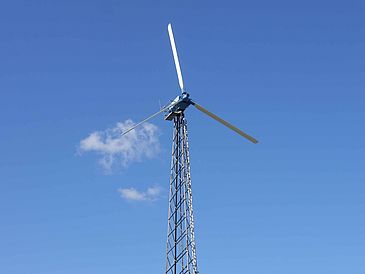Bremen’s ForWind-Centre for Wind Energy Research (Bremen, Hannover, Oldenburg) coordination office has initiated a research project at the University of Bremen to preserve equipment, maintenance support, minimize expenses, and maximize wind yield. The aims of the project are the ecologically and economically optimum operation of the wind turbines with the help of a digital twin. ForWind members, the Institute for Integrated Product Development (BIK), and the Institute for Electrical Drives, Power Electronics and Components (IALB) are working with eight partners to develop a research wind turbine within three years into a cyber-physical system.
The title of the research project is Concept and design of a cyber-physical system for the holistic development of wind turbines (WindIO). Its total volume is 3.1 million euros, where 2.1 million euros are being funded by the German Federal Ministry for Economic Affairs and Energy as part of the 7th Energy Research Program of the Federal Government - Innovations for the Energy Transition. The project is supported by the project management company Jülich.
Besides BIK and IALB as research partners, another five companies are involved as development and application partners: CONTACT Software (Bremen), Pumacy Technologies (Berlin), fibretech composites (Bremen), Deutsche WindGuard (Varel), and SWMS Consulting (Oldenburg), as well as associated partners Windrad Engineering (Bad Doberan), energy & meteo systems (Oldenburg), and Deutsche Windtechnik Service (Ostenfeld).
Benefits of "Digital Twin"
If the potentials offered by digitization were exploited more efficiently, then the wind turbines could be operated in a more environmentally friendly and economical way. Their research and development activities focus on the concept of the "digital twin". This is the virtual equivalent of a real and existing physical system, such as a wind energy facility. In the WindIO project, the digital twin represents the dynamic model of the research wind turbine of type "Krogmann 15-50" of the IALB. Furthermore, the second research wind turbine of the University of Bremen will be ustilized for WindIO research - a 3.4-megawatt turbine facility operated by the project partner Deutsche WindGuard.
Prediction of Field Performance and Operating Lifetime
The operating data must be permanently recorded and fed into the twin in order to digitally map the real conditions in real time. This requires a large amount of sensor data. The system is transformed into a cyber-physical system (CPS) by connecting the mechanical and electrical components via a communication network to an information processing system. In fact, the digital twin is a specific application of a CPS. Predictive analysis functions and holistic condition monitoring are its key features, which provide support during the entire lifecycle of a wind turbine facility - from the production, installation, operation, and maintenance to the final recycling. For instance, linking weather and load conditions allows for the prediction of the operating performance and service life of the turbines.
Test with Bremen’s 3.4-Megawatt Research Wind Turbine
The software architecture developed on the basis of the Krogmann 15-50 is to be applied parallel for a digital twin of the second research wind turbine. This will help to investigate whether and how this methodology can also be applied to larger turbines, thus evaluating the effectiveness of the concept.
“To date, digital twin technology has not been utilized extensively in wind energy systems. This is due to mostly restrictive information management in the wind industry, which delays the development of higher-level operation and optimization strategies. Consequently, the potential of the digitization cannot be fully exploited,” states Dr.-Ing. Christian Zorn, head of the ForWind coordination office, University of Bremen. One of the project goals is therefore particularly close to his heart: “With the WindIO twin, we want to establish a database that enables the exchange of plant-specific information for the different stakeholders.”
Universal, Freely Accessible Platform
WindIO is intended to create a freely accessible, transparent data basis that is useful for the development and integration of new ideas and optimization approaches. This opens up completely new possibilities for comprehensive research activities with real field data, serving as a basis for technical as well as economic simulations for business model development.
The WindIO system is to contribute to the significant improvement of the maintenance forecasts and the load-minimizing control of the wind turbines. It should be possible to guarantee optimum operation management by considering the individual boundary conditions. This contributes to a considerable reduction in the costs of energy generation and the best possible conservation of resources.
Sabine Nollmann
Contact:
Dr.-Ing. Christian Zorn
Head of the ForWind coordination office
University of Bremen
Phone: +49 421 218-62669
Email: christian.zornprotect me ?!uni-bremenprotect me ?!.de
Dr.-Ing. Jan-Hendrik Ohlendorf
Institute for Integrated Product Development (BIK)
University of Bremen
Phone: +49 421 218-64 871
Email: johlendorfprotect me ?!uni-bremenprotect me ?!.de
Further Information:
www.brementestturbine.science (project homepage) (in German only)
www.bik.uni-bremen.de/index_eng.php
www.ialb.uni-bremen.de (in German only)
www.forwind.de/en/
www.uni-bremen.de/en/
Photos for download:
www.brementestturbine.science/files/content/2020-10_WindIO_Fotos_zu_Pressemitteilung.zip

